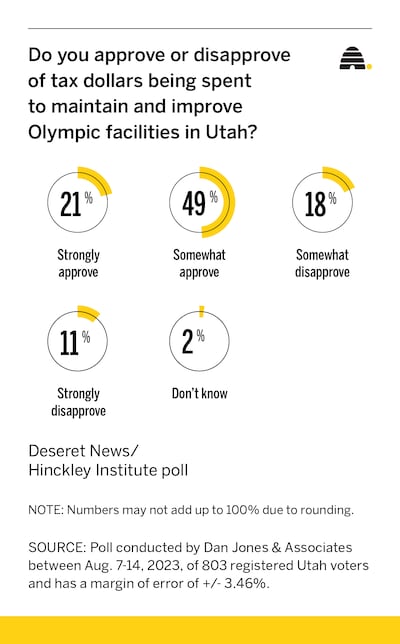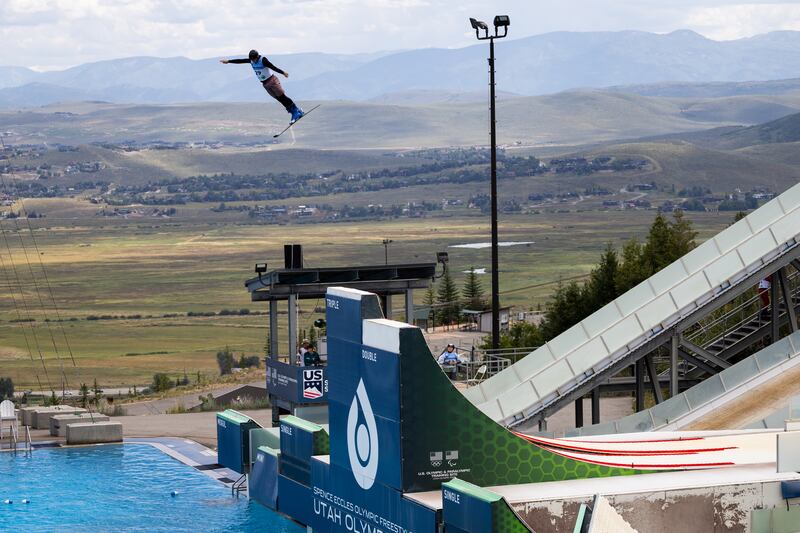A sizable majority of Utahns support spending tax dollars to maintain and improve the state’s Olympic facilities, according to a new Deseret News/Hinckley Institute of Politics poll.
Seventy percent of Utahns approve of their taxes being used for the former 2002 Winter Games venues, an expenditure that could end up exceeding more than $140 million, while just 29% disapprove and 2% don’t know.

“Really? Oh, wow, that’s fantastic,” said Fraser Bullock, president and CEO of the Salt Lake City-Utah Committee for the Games that’s bidding to host another Olympics, in 2030 or 2034.
Bullock said the poll results underscore how much Utah “loves the Games.”
The willingness to fund facilities is also a boost to Salt Lake City’s bid, which faces competition for a Winter Games from Sapporo, Japan; Vancouver, Canada; and cities in Sweden, Switzerland and, as of earlier this summer, France.
“Of course it helps an Olympic bid, just to see that tangible support,” he said, adding that “preserving and enhancing the legacy from 2002 for our communities and for the world is a very worthwhile endeavor.”
Bullock pointed out, however, that the bid committee has not sought tax dollars. The more than $2.2 billion budget for hosting another Olympics does not include any local or state money, instead relying largely on the sale of sponsorships, broadcast rights and tickets.
The poll was conducted Aug. 7-14 of 803 registered Utah voters by Dan Jones and Associates for the Deseret News and the University of Utah’s Hinckley Institute of Politics and has a margin of error of plus or minus 3.46 percentage points.
The backing from Utahns is “exceptionally high,” Hinckley Institute of Politics Director Jason Perry said. “Utahns are fiscally conservative. They worry about where public funds are going. But it’s clear the Olympics are different. The Olympics are important to Utahns.”
That should send “a very clear message” to the International Olympic Committee, which put off picking the hosts of the upcoming Winter Games last December. Now, a final vote isn’t anticipated until some time next year.
“The reality is, Utahns want the Olympics. They’re willing to pay for it and they want it here soon,” Perry said, at a time when there have been “difficult discussions around the world about the benefit of hosting,” causing some past Winter Games bidders to drop out.
In contrast, he said Utahns “have prepared for it to be here over the years. When the time comes, Utah will stand up once again in a spectacular way and host the world, in a way that everyone would be proud of. It is not common to have this kind of support for any project.”
Another Olympics in Utah would utilize all of the 2002 venues, including the bobsled, luge and skeleton track and ski jumps at the Utah Olympic Park in Park City and the speedskating track at the Utah Olympic Oval in Kearns.
In 1989, voters approved a statewide referendum that endorsed building those facilities with $59 million in state tax dollars, an investment that was paid back by 2002 Olympic organizers.
Profits from the Salt Lake City Games were also used to endow what’s become the Utah Olympic Legacy Foundation, which runs the state-built facilities, along with the Soldier Hollow Nordic Center in Wasatch Mountain State Park.
The Utah Legislature began providing funding after a 2017 legislative audit of the foundation recommended the state come up with $39.3 million over 10 years “to bring assets up to current day standards and sport-specific technical requirements.”
So far, lawmakers have allocated nearly $92 million to Olympic facilities, including about $9 million for venues not operated by the foundation, including the Maverik Center in West Valley City and the Peaks Ice Arena in Provo.
By the time the 10 years of funding is done, the total could be more than $140 million.
How Utahns use the 2002 venues
Colin Hilton, the foundation’s president and CEO, said he wasn’t surprised by the poll results because many Utahns have “regular interactions” with what are intended to be community recreation centers just as much as venues for elite athlete training and competition.
“Whether their kids have been in a program, or whether they’re coming to an event or engaging in one of our public activities at the facilities, I think most people have had some sort of touchpoint in a favorable way,” Hilton said.
That’s why Melissa Grieve, a Salt Lake City teacher, supports funding the facilities.
She took her 10-year-old daughter and 15-year-old son to the speedskating oval a couple of years ago to skate as well as learn about a Winter Games held before either of them were born.
“It was a great opportunity to talk to them about the Olympics and how we hosted the Olympics here and some memories I had about the world coming here,” Grieve said, noting the event helps show “how we’re connected to a bigger world.”
Even though she’d like to see more money spent in Utah on education, Grieve said she loves the way the Olympics “broadens people’s minds and understanding of the world.” Family members visiting from Florida, she said, have also made the trek to the Kearns oval.
University of Utah student Mason Holman recalls competing on the ice rinks at the oval as a member of Murray High School’s hockey team and even being invited to try out for the U.S. speedskating team.
Holman, who also owns his own construction business, said he only somewhat approves of tax dollars going to the facilities.
“It is tax dollars that could be spent on other things,” he said, adding he does see benefits.
“Those are places that bring lots of tourism to Utah and eventually could bring the Olympics back, which would be really good for the economy and for the people of Utah,” Holman said. “That’s why I slightly approve, because I feel like it is a net positive.”
What’s the return on investing in Olympic facilities?
Bullock said there’s a significant return on investing in the facilities for Utah taxpayers, even beyond economics. Not only do they offer recreational opportunities for children and adults, the venues also welcome athletes from Team USA and the world, he said.
Another Olympics in Utah could make the facilities self-sufficient, Bullock said, acknowledging that’s a “lofty goal.” It’s one that may be more likely to be achieved if Salt Lake City were to become part of a potential pool of permanent Winter Games hosts.
The IOC is scheduled in October to discuss the possibility of rotating future Winter Games among places considered able to provide consistently cold conditions as the climate changes.
A decision by IOC leaders on advancing their preferred hosts for 2030 and 2034 under the new, less formal bid process could also come in October, although a final vote by the full membership on the location of those Winter Games isn’t anticipated until next year.
Correction: In a previous version, the margin of error was incorrectly listed as plus or minus 4.46% in the story and graphic. The correct margin of error is 3.46%.


